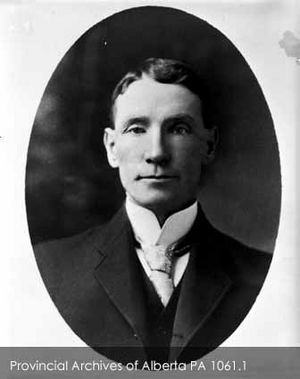Albert Robertson facts for kids
Quick facts for kids
Albert John Robertson
|
|
|---|---|
 |
|
| Leader of the Official Opposition in Alberta | |
| In office March 15, 1906 – February 25, 1909 |
|
| Preceded by | position established |
| Succeeded by | R. B. Bennett |
| Member of the Legislative Assembly of Alberta | |
| In office November 9, 1905 – March 22, 1909 |
|
| Preceded by | New district |
| Succeeded by | Louis Roberts |
| Constituency | High River |
| Personal details | |
| Born | September 17, 1864 Markham, Ontario |
| Died | January 3, 1952 (aged 87) Three Hills, Alberta |
| Political party | Conservative |
| Residence | Nanton, Alberta |
| Occupation | Farmer, businessman, later lawyer |
Albert John Robertson was a Canadian politician from Alberta. He made history as the first ever Leader of the Opposition in the province. He led the Conservative party in the Legislative Assembly of Alberta from 1905 to 1909.
Contents
Albert Robertson's Political Journey
Albert Robertson lived in Nanton, Alberta, and was known for his large farming business. He also managed a company called Nanton Grain & Lumber. In 1905, he became the Conservative candidate for the High River area in Alberta's first provincial election.
He won a very close election against the Liberal candidate, Richard Alfred Wallace. It took over a month to get the final results! Albert Robertson was one of only two Conservatives elected to the Legislative Assembly of Alberta. The other was Cornelius Hiebert. Since the main Conservative leader, R. B. Bennett, didn't win his election, Albert Robertson became the leader of the small group of politicians who opposed the government. This group is called the "Opposition."
Standing Up for Alberta
As the Leader of the Opposition, Albert Robertson often spoke out against the government led by Alexander Cameron Rutherford. He had strong opinions on several important topics:
- Alberta Joining Canada: He disagreed with some of the rules Alberta had to follow when it became part of Canada. For example, he didn't like that the province had to help fund Roman Catholic schools. He also thought Alberta should control its own natural resources, not the federal government.
- Public Services: He believed that services like telephone systems and railways should be owned by the public, not private companies. At that time, the government preferred private control.
- Choosing a Capital City: Edmonton was chosen as a temporary capital for Alberta. Robertson wanted the government to pick a permanent capital quickly. He felt they were avoiding the decision to keep everyone happy.
- Fair Elections: He also thought the rules for election areas were unfair. He felt that Edmonton and Calgary having two seats each was too much. He also believed that waiting five years between elections was too long.
Challenges as Opposition Leader
Albert Robertson faced many challenges. It was hard for just two opposition members to make a big difference against a large government majority. Also, much of the government's early work was simply setting up the new province.
His fellow Conservative, Cornelius Hiebert, wasn't very interested in party politics. Hiebert often agreed with the government and later left the Conservative party. Despite Robertson's efforts, the Conservatives decided not to officially make him their permanent leader for the next election in 1909.
In that 1909 election, Albert Robertson ran again in a new area called Nanton. However, he was defeated by the Liberal candidate, John M. Glendenning.
Life After Politics
After leaving his political role, Albert Robertson became a partner in a real estate company in Hanna. This company closed in 1913.
Even though he was over 50 years old, he decided to go back to school to study law! He finished his studies in 1917 and became a lawyer in 1918. He then practiced law in Three Hills.
In 1913, Albert Robertson tried to get back into politics. He ran in the Hand Hills area, but he was defeated again by the Liberal candidate, Robert Eaton.
Images for kids


